
Diesel Duck
26 July 2013 | On board Diesel Duck
26 July 2013 | Leamington, Canada
25 April 2013 | Florida
26 March 2013 | Florida
27 February 2013 | Stuart, Florida
10 February 2013 | Beautiful Florida
24 January 2013 | Key West, Florida
26 December 2012 | Miami Beach
07 December 2012 | Miami Beach
27 November 2012 | Stuart, Florida
15 November 2012 | Wrightville Beach, NC
05 November 2012 | Chesapeake City, MD
01 November 2012 | New York, NY
30 October 2012 | Half Moon Bay Marina
29 October 2012 | Croton-on-Hudson, NY
23 October 2012 | The New York State Canal System
14 August 2012 | Leamington, Canada
20 June 2012 | Leamington, Ontario
20 June 2012 | Leamington, Ontario
13 May 2012 | In the Erie Canal System
Battery and 12 VDC power talk #4
11 February 2012 | Miami Beach, Florida
Benno
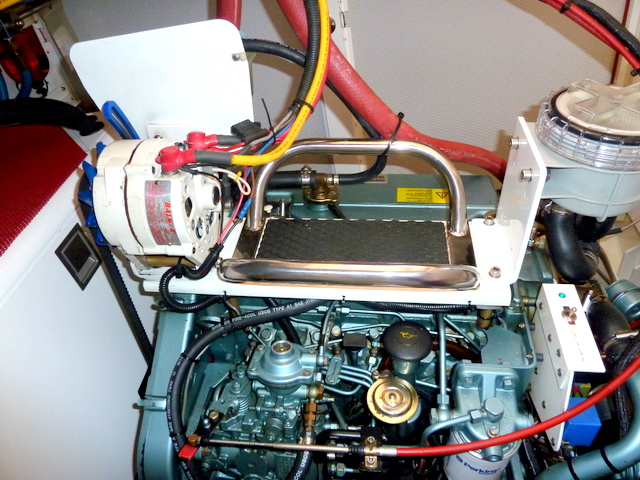
Battery chargers galore
Any device which recharges your in-use or discharged battery bank is a battery charger. A battery charger can have different faces. For instant, your engine alternator is a kind of battery charger. The alternator's job is to recharge your battery up to maximum. The standard alternator is good enough to do the job. A standard alternator has a built-in regulator which controls the flow of electricity to the battery without harming the battery. But is the regulator efficient? No! It will waste a lot of charging time to bring the battery up to snuff. It does fine in a car where your motor runs for hours on a highway. We may include a speed boat which does the same, but a cruising boat, trawler, sailboat or motorhome running on fuel efficient low RPMs, the built-in regulator will slave, waste time and have a hard time to fully charge up your starter or house bank. Here it would be advisable to replace the built-in regulator with an aftermarket smart regulator. These smart regulators can be easily fitted. (look at the last picture of this write up)
These smart regulators for alternators are a real blessing for boat owners. They incorporate very smart thinking into the charging technique. It begins with ramping up the belt load on the drive belt to prevent belt slipping and belt wear. Which is, it starts with hardly any load on the alternator pulley and then gradually increases the load to the alternator's rotor pulley as your diesel engine warms up. You don't have the sudden jerk on the alternator belt with the momentary wear and tear you would get on a fully loaded alternator start-up. The regulator provides multi stage charging and some of them have temp sensors to sense the temperature of the alternator itself to reduce the workload of the alternator when it gets too hot. By doing this it permits the pulley's fan blade to cool down the copper windings to prevent a burnout of the alternator. Another temp sensor will sense the battery temperature on some top model smart regulator. In my opinion, a smart regulator for an alternator is the only way to go these days for a boat owner. It lets you charge your batteries with the main engine fast and efficiently. The charging power of an alternator with a smart regulator should not exceed 25% of the battery's bank capacity.
The other way to get good charging power is to replace the standard alternator with a high performance alternator which incorporates already a smart regulator or, fit a high performance alternator as a second mounted alternator. It can be done. On Diesel Duck, I mounted a BALMAR 100 amp alternator piggyback on top of the diesel engine. See the picture above.
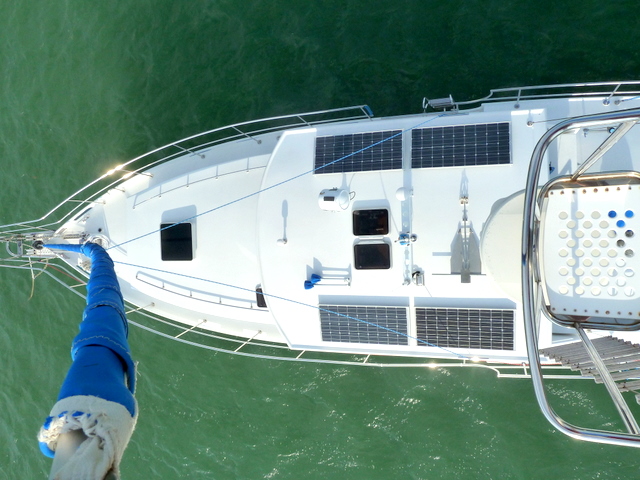
Another kind of charger is a solar panel mounted onto a boat. The panel or panels could be fitted to the guard rails or on top of a pilot house, or on a stern mounted arch. Solar panels are very efficient during daylight hours. Especially in sunlight they are true performers and cost efficient. Most cruising boats have them and could not do without them. They harness more electricity than wind generators and doing this quietly without noise. A solar controller is the smart regulator for solar panels and should give you the choice of selecting the battery type: Wet cell; Gel or AGM. On Diesel Duck we have a 300 Watt array consisting of 4 panels mounted on top of the pilot house. Let me tell you, these solar panels provide us during daylight with enough electricity to run all the 12 volt stuff, like: electric toilet, water pump, sump pump, lights, ventilators, 9 cubic ft. freezer, under counter fridge and the 120 volt inverter for laptop computer etc.

Wind generators are chargers too, many boats have them. You see them mounted onto stub masts on the stern or on tripods on top of the wheelhouse. Sometimes they are fastened to the rigging. Some wind generators produce a remarkable amount of electricity in a strong wind of more than 18 knots. But you will hear the noise. It can only be a woosh, woosh, or some produce a disturbing noise, which sounds like the devil is loose in the rigging, very annoying to the neighborhood. The high end wind generators come with a built-in regulator or external regulator. These wind generators will safely charge the battery bank. Other wind generators have no regulator and their manufacturers preach you could charge your battery bank up to 2-1/2% of the bank's capacity unregulated. But some wind generators pump out 25 amps in peak times and when you are in a windy area where it blows 25 knots or more for a day, I would say: "Ho, ho, hold it there!" When 25 amps equal 2-1/2% unregulated, this means my battery bank must be of 1000 amp capacity to eat this kind of power without being cooked. Which boat has that kind of 1000 amp battery bank? It must be a big boat. Diesel Duck's battery bank capacity is 950 amp on the house bank. The average cruising boat's house bank capacity lies by 500-600 amp. The 2-1/2% bracket is by far too much, 1% is more realistic. A wind generator without regulator should be treated with caution. They are being sold, so please watch out!
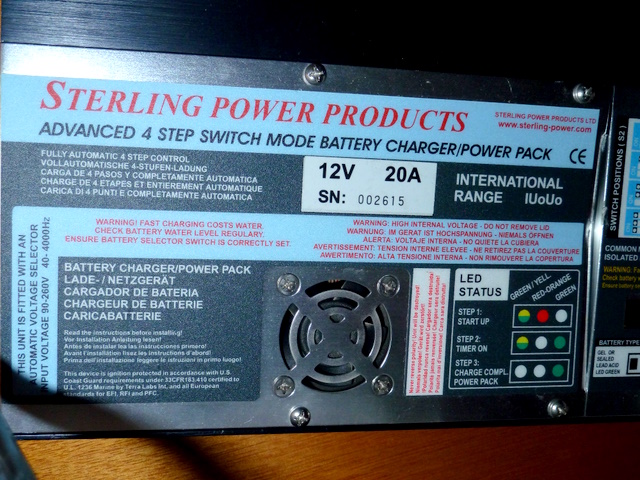
I talked about alternators, solar panels and wind generators. These are the faces of battery chargers. The only one which is left out is the unit you know as a battery charger. The actual battery charger you plug into an AC outlet to charge the batteries. They come as the "el cheapo" 6 amp unregulated charger. Next, the "off the mill" automotive charger with built-in amp meter. To top it up then, there is the real McCoy the famous smart battery charger, like the charger in the picture above.
The "el cheapo" unregulated charger is a no good choice at all. Most of them pump out up to 6 amp. Unregulated charging of a battery bank should not exceed 1% of the bank's capacity. In this case you should have a 600 amp battery bank capacity, otherwise, it will be cooked when you don't watch it. Stay away from these chargers.
The "off the mill" automotive charger with built-in amp meter is regulated and can be used. Some even have a battery type selector switch which lets you switch between flooded or sealed batteries. Flooded is wet cell and sealed, is AGM batteries. The charger's power should not exceed 10% of the battery bank's capacity. For gel batteries, this charger is not designed to charge these. These types of chargers charging voltage will exceed 14.1 volt and this is too much for gel batteries. To use this charger, you hook up the charging leads to the battery. The black lead to the minus pole and the red lead to the plus pole, then plug the AC cord into a 120 volt outlet. Now you watch the amp meter and when the amps go down, the battery is charged and you unplug the AC cord. In case you forget to do this, you got yourself a problem. It will slowly cook your battery. So this type of charger cannot be left unsupervised. I recommend using a smart charger for a marine battery bank.
The smart battery charger is the best way to charge a battery bank when tied to a dock or under anchor. Tied to a dock, you use the shore power and under anchor, you fire up the Honda generator or your built-in diesel generator. Smart battery chargers are multi stage chargers, most of them are 3. stage chargers. Some top of the line smart battery chargers have even a 4. stage and a 5. stage. The 1. stage is the bulk stage, which does the main job in charging with a constant current. The 2. stage is the absorption stage with a reduced current charge. The 3. stage is the float stage, with an even more reduced current charge to maintain a small charge without damage to the battery for the period of time it takes you to get around to switch the charger off. The 4. stage is the equalizing stage to equalize wet cell battery banks once or twice a year. The 5. stage is the maintenance stage to leave your batteries plugged in when the boat is in storage.
These smart chargers can charge wet cell, gel or AGM batteries. The battery type is selected via soft switching, dip switches or slide switches. The top of the line smart chargers have provisions to connect battery temp sensors and can charge more than one battery bank at the same time. There is a domestic series of smart battery chargers which accept only the 120 VAC 60 cycle input on the AC side and there is the international series of smart battery chargers which accept any voltage from 80 - 260 V AC and any cycle from 40-80 cycle on the AC side input. These specs vary from brand to brand. With the international series you cover every different country's voltage and cycle (Hertz). A smart way to go. When selecting the size of the smart battery charger, the size should not exceed 25% of the battery bank capacity by wet cell batteries. Example: 100 amp battery bank = 25 amp smart charger. By gel batteries it could be high as 30% and by AGM batteries up to 40% of the battery bank capacity. It can be less, but never more.
How long does it take to charge a battery? It depends on the age of the battery and the size of the charging equipment. But one thing is for sure, a flooded wet cell battery is quicker charged because the fluid electrolyte which consists of 35% sulfuric acid and 65% of distilled water and with the lead antimony plates is more conductive than the lead calcium plates with the absorbed glass mat electrolyte of the AGM batteries. It takes longer to charge AGM batteries, but on the other hand you could use a bigger smart charger on AGM batteries and this will speed up the charging process, right!(thank you Cosmos of "Koukla" for pointing this out).
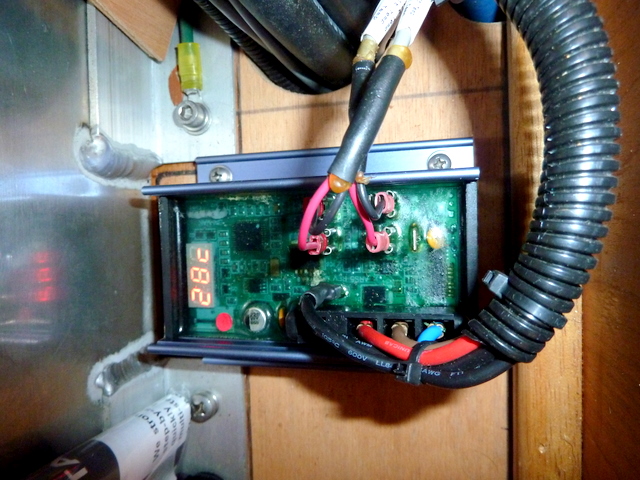
How do we charge our batteries on Diesel Duck? In the morning hour we start the 120 V AC diesel generator and switch on the 4. stage battery charger, which is part of our 2500 watt sine wave inverter/ charger from Trace (model: SW 2512). The charger part pumps out 150 amp. Part of the 120 volt AC from the diesel generator will go toward toaster and coffeemaker. After an hour of charging the house bank, we shut the diesel generator down. Now our solar panel array of four mounted solar panels on top of the pilot house roof takes over and supplies enough 12 VDC for the day up to 19:30 hour. At that time we start the diesel generator (5 KW Northern Lights) up and switch the battery charger on until 21:00 hrs or about 1-1/2 hrs. There is plenty of 120 volts available to use electrical kitchen tools while preparing dinner and to watch a movie with the surround sound Bose system going. At 21:00 hrs we shut the diesel generator down. In the morning when we get up the built-in panel voltmeter still reads 12.5 volts.
Diesel Duck used to have an "Air-X Marine" wind generator mounted on top of the pilot house roof, but it blew the brake circuit of the built-in regulator during a strong gust in Venezuela in July 06. Had it fixed by the manufacturer, but the Air-X Marine is designed to shut down at 28 knots of wind. Down in Patagonia by Cape Horn we had to tie the blades always up. The wind blows generally between 25 - 50 knots down there. Too much wind for this brand of wind generator and we did not want to risk blowing the brake circuit again. The bugger was noisy as hell too. We sold the unit in Grenada and at this moment we are not sprouting a wind generator on Diesel Duck. The recuperated dollars found a new good use when we purchased an international 4. stage Sterling 20 amp battery charger with auto ranging AC input at Island Water World in Grenada, which could eat the worldwide different voltages. I wired a short pigtail extension cord with a 120 volt plug to it. The Sterling battery charger has its own built-in muffin fan for cooling and has thus far worked well without any hiccup!
This concludes the 4 part battery and 12 VDC power talk write-up.
Any device which recharges your in-use or discharged battery bank is a battery charger. A battery charger can have different faces. For instant, your engine alternator is a kind of battery charger. The alternator's job is to recharge your battery up to maximum. The standard alternator is good enough to do the job. A standard alternator has a built-in regulator which controls the flow of electricity to the battery without harming the battery. But is the regulator efficient? No! It will waste a lot of charging time to bring the battery up to snuff. It does fine in a car where your motor runs for hours on a highway. We may include a speed boat which does the same, but a cruising boat, trawler, sailboat or motorhome running on fuel efficient low RPMs, the built-in regulator will slave, waste time and have a hard time to fully charge up your starter or house bank. Here it would be advisable to replace the built-in regulator with an aftermarket smart regulator. These smart regulators can be easily fitted. (look at the last picture of this write up)
These smart regulators for alternators are a real blessing for boat owners. They incorporate very smart thinking into the charging technique. It begins with ramping up the belt load on the drive belt to prevent belt slipping and belt wear. Which is, it starts with hardly any load on the alternator pulley and then gradually increases the load to the alternator's rotor pulley as your diesel engine warms up. You don't have the sudden jerk on the alternator belt with the momentary wear and tear you would get on a fully loaded alternator start-up. The regulator provides multi stage charging and some of them have temp sensors to sense the temperature of the alternator itself to reduce the workload of the alternator when it gets too hot. By doing this it permits the pulley's fan blade to cool down the copper windings to prevent a burnout of the alternator. Another temp sensor will sense the battery temperature on some top model smart regulator. In my opinion, a smart regulator for an alternator is the only way to go these days for a boat owner. It lets you charge your batteries with the main engine fast and efficiently. The charging power of an alternator with a smart regulator should not exceed 25% of the battery's bank capacity.
The other way to get good charging power is to replace the standard alternator with a high performance alternator which incorporates already a smart regulator or, fit a high performance alternator as a second mounted alternator. It can be done. On Diesel Duck, I mounted a BALMAR 100 amp alternator piggyback on top of the diesel engine. See the picture above.

Another kind of charger is a solar panel mounted onto a boat. The panel or panels could be fitted to the guard rails or on top of a pilot house, or on a stern mounted arch. Solar panels are very efficient during daylight hours. Especially in sunlight they are true performers and cost efficient. Most cruising boats have them and could not do without them. They harness more electricity than wind generators and doing this quietly without noise. A solar controller is the smart regulator for solar panels and should give you the choice of selecting the battery type: Wet cell; Gel or AGM. On Diesel Duck we have a 300 Watt array consisting of 4 panels mounted on top of the pilot house. Let me tell you, these solar panels provide us during daylight with enough electricity to run all the 12 volt stuff, like: electric toilet, water pump, sump pump, lights, ventilators, 9 cubic ft. freezer, under counter fridge and the 120 volt inverter for laptop computer etc.

Wind generators are chargers too, many boats have them. You see them mounted onto stub masts on the stern or on tripods on top of the wheelhouse. Sometimes they are fastened to the rigging. Some wind generators produce a remarkable amount of electricity in a strong wind of more than 18 knots. But you will hear the noise. It can only be a woosh, woosh, or some produce a disturbing noise, which sounds like the devil is loose in the rigging, very annoying to the neighborhood. The high end wind generators come with a built-in regulator or external regulator. These wind generators will safely charge the battery bank. Other wind generators have no regulator and their manufacturers preach you could charge your battery bank up to 2-1/2% of the bank's capacity unregulated. But some wind generators pump out 25 amps in peak times and when you are in a windy area where it blows 25 knots or more for a day, I would say: "Ho, ho, hold it there!" When 25 amps equal 2-1/2% unregulated, this means my battery bank must be of 1000 amp capacity to eat this kind of power without being cooked. Which boat has that kind of 1000 amp battery bank? It must be a big boat. Diesel Duck's battery bank capacity is 950 amp on the house bank. The average cruising boat's house bank capacity lies by 500-600 amp. The 2-1/2% bracket is by far too much, 1% is more realistic. A wind generator without regulator should be treated with caution. They are being sold, so please watch out!

I talked about alternators, solar panels and wind generators. These are the faces of battery chargers. The only one which is left out is the unit you know as a battery charger. The actual battery charger you plug into an AC outlet to charge the batteries. They come as the "el cheapo" 6 amp unregulated charger. Next, the "off the mill" automotive charger with built-in amp meter. To top it up then, there is the real McCoy the famous smart battery charger, like the charger in the picture above.
The "el cheapo" unregulated charger is a no good choice at all. Most of them pump out up to 6 amp. Unregulated charging of a battery bank should not exceed 1% of the bank's capacity. In this case you should have a 600 amp battery bank capacity, otherwise, it will be cooked when you don't watch it. Stay away from these chargers.
The "off the mill" automotive charger with built-in amp meter is regulated and can be used. Some even have a battery type selector switch which lets you switch between flooded or sealed batteries. Flooded is wet cell and sealed, is AGM batteries. The charger's power should not exceed 10% of the battery bank's capacity. For gel batteries, this charger is not designed to charge these. These types of chargers charging voltage will exceed 14.1 volt and this is too much for gel batteries. To use this charger, you hook up the charging leads to the battery. The black lead to the minus pole and the red lead to the plus pole, then plug the AC cord into a 120 volt outlet. Now you watch the amp meter and when the amps go down, the battery is charged and you unplug the AC cord. In case you forget to do this, you got yourself a problem. It will slowly cook your battery. So this type of charger cannot be left unsupervised. I recommend using a smart charger for a marine battery bank.
The smart battery charger is the best way to charge a battery bank when tied to a dock or under anchor. Tied to a dock, you use the shore power and under anchor, you fire up the Honda generator or your built-in diesel generator. Smart battery chargers are multi stage chargers, most of them are 3. stage chargers. Some top of the line smart battery chargers have even a 4. stage and a 5. stage. The 1. stage is the bulk stage, which does the main job in charging with a constant current. The 2. stage is the absorption stage with a reduced current charge. The 3. stage is the float stage, with an even more reduced current charge to maintain a small charge without damage to the battery for the period of time it takes you to get around to switch the charger off. The 4. stage is the equalizing stage to equalize wet cell battery banks once or twice a year. The 5. stage is the maintenance stage to leave your batteries plugged in when the boat is in storage.
These smart chargers can charge wet cell, gel or AGM batteries. The battery type is selected via soft switching, dip switches or slide switches. The top of the line smart chargers have provisions to connect battery temp sensors and can charge more than one battery bank at the same time. There is a domestic series of smart battery chargers which accept only the 120 VAC 60 cycle input on the AC side and there is the international series of smart battery chargers which accept any voltage from 80 - 260 V AC and any cycle from 40-80 cycle on the AC side input. These specs vary from brand to brand. With the international series you cover every different country's voltage and cycle (Hertz). A smart way to go. When selecting the size of the smart battery charger, the size should not exceed 25% of the battery bank capacity by wet cell batteries. Example: 100 amp battery bank = 25 amp smart charger. By gel batteries it could be high as 30% and by AGM batteries up to 40% of the battery bank capacity. It can be less, but never more.
How long does it take to charge a battery? It depends on the age of the battery and the size of the charging equipment. But one thing is for sure, a flooded wet cell battery is quicker charged because the fluid electrolyte which consists of 35% sulfuric acid and 65% of distilled water and with the lead antimony plates is more conductive than the lead calcium plates with the absorbed glass mat electrolyte of the AGM batteries. It takes longer to charge AGM batteries, but on the other hand you could use a bigger smart charger on AGM batteries and this will speed up the charging process, right!(thank you Cosmos of "Koukla" for pointing this out).

How do we charge our batteries on Diesel Duck? In the morning hour we start the 120 V AC diesel generator and switch on the 4. stage battery charger, which is part of our 2500 watt sine wave inverter/ charger from Trace (model: SW 2512). The charger part pumps out 150 amp. Part of the 120 volt AC from the diesel generator will go toward toaster and coffeemaker. After an hour of charging the house bank, we shut the diesel generator down. Now our solar panel array of four mounted solar panels on top of the pilot house roof takes over and supplies enough 12 VDC for the day up to 19:30 hour. At that time we start the diesel generator (5 KW Northern Lights) up and switch the battery charger on until 21:00 hrs or about 1-1/2 hrs. There is plenty of 120 volts available to use electrical kitchen tools while preparing dinner and to watch a movie with the surround sound Bose system going. At 21:00 hrs we shut the diesel generator down. In the morning when we get up the built-in panel voltmeter still reads 12.5 volts.
Diesel Duck used to have an "Air-X Marine" wind generator mounted on top of the pilot house roof, but it blew the brake circuit of the built-in regulator during a strong gust in Venezuela in July 06. Had it fixed by the manufacturer, but the Air-X Marine is designed to shut down at 28 knots of wind. Down in Patagonia by Cape Horn we had to tie the blades always up. The wind blows generally between 25 - 50 knots down there. Too much wind for this brand of wind generator and we did not want to risk blowing the brake circuit again. The bugger was noisy as hell too. We sold the unit in Grenada and at this moment we are not sprouting a wind generator on Diesel Duck. The recuperated dollars found a new good use when we purchased an international 4. stage Sterling 20 amp battery charger with auto ranging AC input at Island Water World in Grenada, which could eat the worldwide different voltages. I wired a short pigtail extension cord with a 120 volt plug to it. The Sterling battery charger has its own built-in muffin fan for cooling and has thus far worked well without any hiccup!
This concludes the 4 part battery and 12 VDC power talk write-up.
Comments
| Vessel Name: | Diesel Duck |
| Vessel Make/Model: | Diesel Duck 41' - Aluminum |
| Hailing Port: | Toronto, Canada |
| Crew: | Marlene and Benno Klopfer (Photo by Marcie Lynn, Puerto Montt, Chile) |
| About: | |
| Extra: | |
| Home Page: | http://www.sailblogs.com/member/dieselduck |
| Social: |
Gallery not available
Cruising on a Troller Yacht
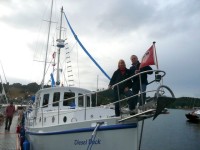
Who: Marlene and Benno Klopfer (Photo by Marcie Lynn, Puerto Montt, Chile)
Port: Toronto, Canada



